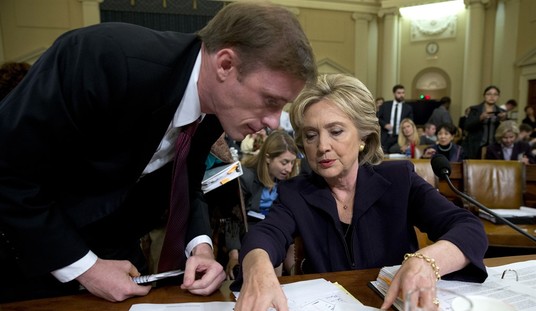Every day since he began running for president, the international media have scoured Donald Trump’s statements and actions in search of something to mock. One day last February, they fastened on an unscripted remark he made at a rally in Florida. “We’ve got to keep our country safe,” he told the crowd. “You look at what’s happening in Germany, you look at what’s happening last night in Sweden. Sweden, who would believe this? Sweden. They took in large numbers. They’re having problems like they never thought possible.”
Trump went on to mention Brussels, Nice, and Paris, the sites of recent terrorist attacks. But the media zeroed in on Sweden, because Trump had made it sound as if something specific and terrible, some act of terrorism or Muslim gang crime or some such thing, had happened in that country the night before. As it happened, that was not the case. “There were questions,” reported the Guardian, “about whether Trump had confused Sweden with Sehwan in Pakistan, where more than 85 people were killed in a suicide bombing at the Sufi shrine on Thursday.” The Guardian also cited dubious Swedish statistics purportedly indicating that crime levels in Sweden had been stable for a long time.
As it turned out, Trump had been referring to an appearance on Tucker Carlson’s Fox News program by filmmaker Ari Horowitz, who had discussed his documentary about the devastating impact of mass Muslim immigration on Sweden. But nobody in the mainstream media wanted to talk about that. No, they preferred to take the opportunity to present Trump as clueless and irresponsible. The New York Times ran articles two days in a row about his supposed gaffe, and claimed that everyone in Sweden had been “flabbergasted” by it. Swedish officials and journals had a particularly good time dismissing it. Former Prime Minister Carl Bildt tweeted: “Sweden? Terror attack? What has he been smoking?” The newspaper Aftonbladet jokingly provided a list of some not-terribly-earthshaking events that had taken place in Sweden on the night in question. For example: “Due to harsh weather in northern parts of Sweden the road E10 was closed between Katterjakk and Riksgransen.”
As noted, Trump made his comment about Sweden last February. Among those who didn’t want to forget it were a group of leading Swedish photographers who, seven months later, put out a coffee-table book entitled (what else?) Last Night in Sweden. In a Stockholm newspaper, The Local, Lee Roden applauded the shutterbugs for challenging “the hysteria about the country provoked by people like U.S. President Donald Trump.” The contributors mailed the first copy to Trump. As I wrote at the time, the pictures in the book depicted a man on a snowmobile, a guy playing the tuba, an old couple playing with their dog, and other such anodyne subjects. There were also pictures showing immigrants in a positive light – for example, a Somali guy pushing an old Swedish woman in her wheelchair. The message couldn’t have been clearer: Sweden is doing just great, thank you, and Muslims have proven to be a wonderfully integrated boon to Swedish society.
Yet as the months went by, more conscientious observers found other reasons to recall Trump’s passing remark. In April, after a terrorist ran down pedestrians with a truck on Drottninggatan in Stockholm, The Telegraph (UK) actually published an article by Hayley Dixon whose headline explicitly raised the question of whether Trump had, perhaps, been right. “Just over six weeks after Donald Trump was mocked across the world for suggesting that Sweden was the victim of a terror attack,” wrote Dixon, “at least three people have been left dead when a hijacked truck ploughed into pedestrians.” Dixon went on to provide an overview – surprisingly honest by mainstream-media standards – of Swedish immigration levels, integration problems, and no-go zones.
Yes, some of us have been writing about these things for a long time. But we’ve done so in non-mainstream media, at “alternative” websites, and our reports have been routinely smeared in established news organs as exaggerated, hysterical, apocryphal, racist, and/or Islamophobic. We may wish that the New York Times, Washington Post, CNN, and the news divisions of CBS, NBC, and ABC – and their equivalents abroad – didn’t matter. But they do. To millions of folks who still buy dead-tree newspapers or turn on the TV at dinnertime to get their news, those traditional sources of information, however full they are of fake news, remain their windows on the world. And so when a paper like the Telegraph runs a piece that at least begins to tell the truth about Sweden, it’s a big deal. For many readers, it will mark the first time they ever discovered that Sweden isn’t a paradise on earth.
Last month, even the New York Times got into the act. Sort of. On December 10, it reported on a Molotov cocktail attack on a Gothenburg synagogue. Of course, being the Times, it managed to sidestep the words Muslim and Islam even though it was clear what was going on: “about 10 young people…began setting fire to objects and throwing them at the synagogue”; the cops “arrested three men in their 20s”; this followed an anti-Israel protest in which participants waved “Palestinian flags” and “yelled that they were going to shoot Jews” and threatened a Malmö “intifada” in Arabic.
Four days after its report on the synagogue bombing, the Times ran an op-ed headlined “The Uncomfortable Truth About Swedish Anti-Semitism” in which Swedish writer Paulina Neuding put the bombing into perspective, noting that her country was undergoing a tsunami of violent attacks on Jewish targets. The Times actually allowed Neuding to mention, nine paragraphs into the piece, that the chief perpetrators of these attacks are Muslims. Reading the first few hundred words, however, I couldn’t help feeling that some Times editor had slashed the Islamic references in the piece down to a minimum. Note the masterly way in which one paragraph near the top of Neuding’s op-ed repeatedly skirts the kind of specificity that journalism is supposed to be all about:
…Both of these recent attacks followed days of incitement [by whom?] against Jews. Last Friday, 200 people [what kind of people?] protested in Malmo against President Trump’s decision to recognize Jerusalem as the capital of Israel. The protesters [again: what kind of protesters?] called for an intifada and promised “we will shoot the Jews.” A day later, during a demonstration in Stockholm, a speaker [what kind of speaker? don’t you know his name?] called Jews “apes and pigs.” There were promises of martyrdom [by whom?].
As someone who’s written op-eds on “sensitive” topics for the Gray Lady, I’m all but certain that this avoidance of the words Muslim and Islam was a result of heavy editorial blue-penciling. Still, for the Times, the Gothenburg news story and the Neuding op-ed were surprisingly candid in regard to facts about which the Newspaper of Record had previously maintained a discreet silence.
If any paper in the world enjoys higher cred among the cultural elite than the New York Times, it’s the Sunday Times of London – which, on January 21, ran its own surprising frank article about Sweden, headlined “Teens roam streets with rifles as crime swamps Sweden.” (Subhead: “The army may be called in to halt a gang surge in immigrant areas.”) Yes, the reporter, Bojan Pancevski, writing from Malmö, felt a need to balance out the nightmare picture with a statement that read like wishful thinking: “Sweden is among the world’s safest, richest and best-run countries enjoying steady growth and rising employment.” But this attempt at reassurance was given the lie by his scrupulous portrait of today’s Sweden at its worst – the ongoing “surge of gang shootings, bombings and sexual assaults,” the “overstretched” police, and the Swedish establishment’s longtime effort to deny reality.
“Rosengård’s main school, which had pupils from nearly 200 different ethnic backgrounds, was closed because of social tension,” Pancevski reported. He quoted a Stockholm police officer, Ted Eriksson, who, at a recent “pro-refugee rally,” had been “stabbed by an Afghan asylum seeker” who “said he wanted to kill a policeman.” Pancevski also visited Rinkeby, an immigrant suburb of Stockholm, where “a group of youths in shell suits aggressively asked why I was in their neighbourhood,” only to turn “more respectful” when he told them he’s “from the Balkans – the homeland of many local criminal kingpins.” In Rinkeby, a cop told Pancevski: “Hating police is part of some of these kids’ cultures.” Let’s face it – hating all of us is part of these kids’ cultures.
Pancevski didn’t mention Trump’s “last night in Sweden” remark, but he did bring up Norwegian immigration minister Sylvi Listhaug, who visited Rinkeby last year, saying she was there to learn about the consequences of “uncontrolled migration and poor integration” At the time, noted Pancevski, Listhaug’s remark created an international incident. Karin Wanngard, mayor of Stockholm, rejected Listhaug’s characterization of Rinkeby, calling it a “fine neighbourhood” that was “teeming with vitality.” In both Sweden and Norway, the media savaged Listhaug, depicting her as both undiplomatic and Islamophobic. Not a few influential voices demanded she be fired. Since then, however, noted Pancevski, the situation in Rinkeby has grown so terrible that Wanngard has been “forced…to change her tune.” In other words, Listhaug was right – just as Trump was right.
Pancevski was straightforward about the “link between immigrants and crime.” He also quoted Neuding’s observations that Sweden is undergoing a “sexual assault crisis” owing to the immigration of “men from extremely patriarchal cultures” and that Sweden’s self-described “feminist government” has “quietly abandoned women.” But Pancevski stopped short, alas, of using the word Islam; his article didn’t even hint at the fact that most of the trouble plaguing neighborhoods like Rosengård and Rinkeby can be traced directly to Islamic teachings about the caliphate, jihad, jizya, relations between believers and infidels, relations between men and women, and so forth. But one can’t expect everything from the mainstream media all at once.









Join the conversation as a VIP Member